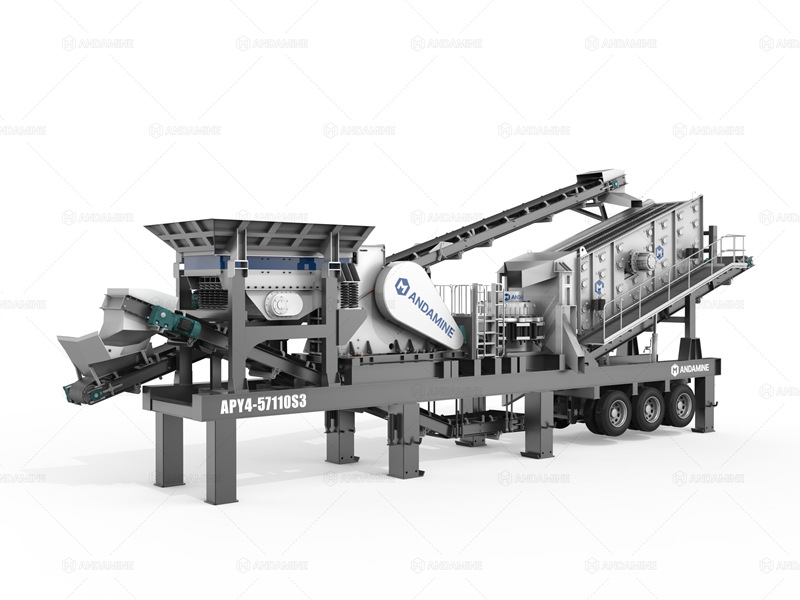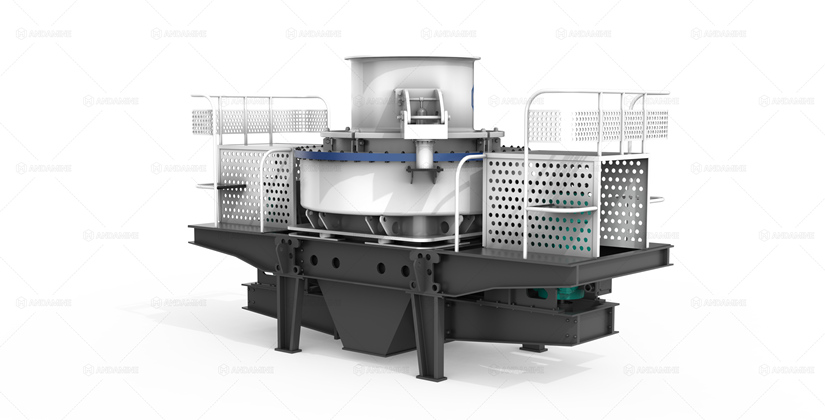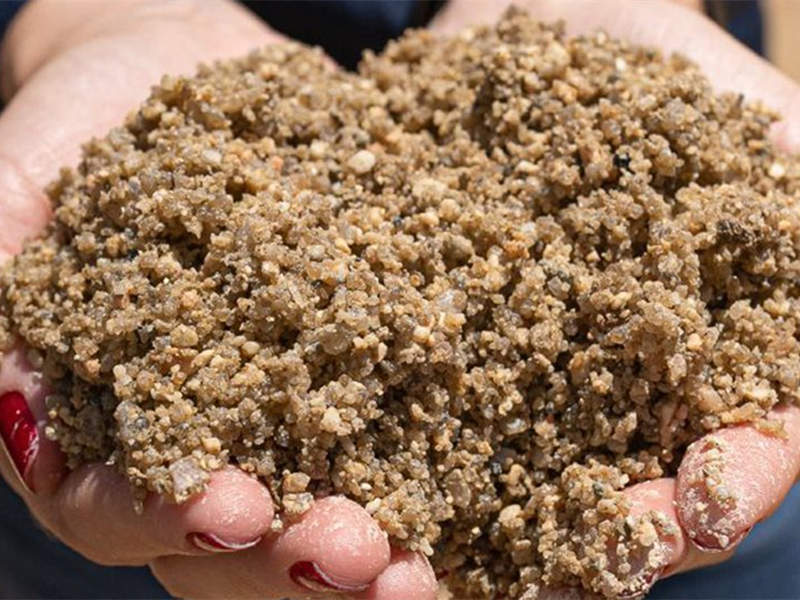A VSI Crusher (Vertical Shaft Impactor) is a high-efficiency rock crushing machine that utilizes a high-speed rotor to accelerate material into a crushing chamber, where impact forces fracture particles through rock-on-rock or rock-on-steel collisions. This versatile equipment excels at refining irregular aggregates into uniformly shaped, cubical end products while simultaneously reducing material moisture content. VSI crushers are the preferred solution for producing premium-quality manufactured sand (M-Sand) and precisely graded aggregates for concrete, asphalt, and road base applications, delivering superior particle shape and size control compared to conventional crushers.

Suitable Rock Types for High-Quality Manufactured Sand
Vertical Shaft Impact crushers effectively process various geological formations into premium construction sand, with performance varying according to mineral composition and structural properties.
Suitable Rock as Manufactured Sand Raw Material



Igneous Rocks
Granite: This silica-rich material produces angular, high-compressive-strength sand ideal for structural concrete, though its abrasiveness accelerates wear part consumption by 15-20% compared to softer stones.
Basalt: Crushed basaltic sand exhibits exceptional particle interlock properties due to its micro-vesicular texture, making it the preferred choice for high-friction applications like airport runways and bridge decks.
Metamorphic Rocks
Quartzite: With 90-98% quartz content, quartzite VSI sand achieves near-perfect gradation for specialty glass manufacturing and epoxy flooring systems requiring ultra-low impurity levels.
Gneiss: The foliated structure of gneiss yields sand with naturally layered cleavage planes, creating self-draining aggregates essential for railway ballast and hydraulic fill operations.
Sedimentary Formations
Limestone: As the most energy-efficient material for VSI processing, limestone produces uniform oval-shaped grains that enhance workability in mortar and plaster applications while reducing cement consumption by 8-12%.
Sandstone: Friable sandstone variants generate fine-modulus sands (1.8-2.2 FM) perfect for brick/block manufacturing, though require rock-on-rock configuration to minimize over-crushing.



Industrial Applications of VSI-Produced Sand
The controlled fragmentation mechanism of Vertical Shaft Impactors creates engineered sands with performance advantages over natural alternatives across multiple sectors.
Construction Materials
Concrete Production: VSI sand crusher-generated sands with 0-5% filler content (<75μm) and 25-30% optimal voids significantly enhance concrete compressive strength (up to 65MPa) while reducing water demand by 7-9% compared to river sand.
Precast Elements: Precisely graded sands between 150-600μm provide the dimensional stability required for architectural precast panels and sound barrier walls, eliminating surface honeycombing defects.
Infrastructure Development Asphalt Pavements: Cubical sand particles with fractured faces in the 1-3mm range improve bitumen adhesion in SMA mixes, increasing road surface durability by 40% against rutting deformation.
Railway Ballast: Granite-derived sands with >80% LA abrasion resistance serve as stabilizing bedding material beneath tracks, effectively distributing dynamic loading forces.
Specialty Industrial Uses
| Application | Required Sand Properties | VSI Advantage |
|---|---|---|
| Glass Manufacturing | >98% SiO₂, <0.1% iron oxides | Minimal contamination in closed-circuit crushing |
| Foundry Casting | AFS 55-65 fineness, spherical grains | Precision particle shaping |
| Water Filtration | 0.4-0.8mm uniform coefficient | Adjustable cascade curtain control |
| Golf Course Bunkers | 0.25-0.85mm rounded particles | Attrition grinding in rock-on-rock mode |
Environmental Remediation
Manufactured sands with controlled permeability profiles (10⁻³ cm/sec) serve as engineered barrier materials in landfill liners and contaminated land capping systems, outperforming natural sands in hydraulic containment consistency.
VSI Crusher Selection Guide: Matching Equipment to Your Operation
Selecting the right VSI crusher for sale involves balancing production goals, site constraints, and long-term operational costs. This guide addresses real-world dilemmas faced by quarry managers, contractors, and plant operators, covering fixed vs. mobile crusher machine configurations, material-specific designs, and ROI-driven considerations.
Fixed vs. Mobile: Core Differences & When to Choose
01Fixed VSI Crusher Plants
Ideal for high-volume, permanent sites (e.g., large quarries or dedicated sand plants). They offer:
- Higher throughput (60–650 t/h) and lower energy consumption per ton.
- Lower upfront costs (e.g., VSI-5000 at ~$150K vs. mobile units at $300K+).
- Integration with existing infrastructure (e.g., conveyor networks, screening plants).
02Mobile VSI Crushers
The mobile portable VSI crusher is suited for temporary projects, limited-space sites, or multi-location operations:
- Zero foundation work: Self-contained with feeders, screens, and conveyors.
- Flexible relocation: Switch sites in <1 hour (e.g., urban demolition or road projects).
- Trade-offs: 30% lower max capacity vs. fixed units and 50% higher initial investment.


Crushing Mode: “Rock-on-Rock” vs. “Rock-on-Steel”
Your material hardness and product specs dictate the optimal mode:
01Rock-on-Rock (ROR)
- Best for: Abrasive materials (granite, quartzite) and high-shape demands (e.g., concrete sand). Result: >95% cubical grains, low wear costs ($0.02–0.05/ton).
- Limitation: 15–20% lower throughput than “rock-on-steel”.
02Rock-on-Steel (ROS)
- Best for: Soft to medium rocks (limestone, dolomite) prioritizing volume over shape.
- Result: Higher yield but more angular particles (70–80% cubical).
- Risk: Wear-part costs 2–3× higher than ROR for abrasive materials.
Material Compatibility: Beyond Hardness
VSI plant performance varies by feed characteristics:
- High-Silica Rocks (Granite, Quartzite): Use ROR + tungsten carbide liners to minimize wear. Expect 15–20% lower rotor life vs. limestone.
- Wet/Clayey Feeds (e.g., River Gravel): Prioritize mobile units with integrated washing to prevent clogging.
- Recycled Concrete/Asphalt: ROS mode + pre-screening removes rebar efficiently. Mobile crushers excel here.

Hidden Costs: What Buyers Overlook
- Wear-Part Access: Hydraulic lid lifters (e.g., VSI-6000+) cut maintenance time by 50%.
- Dust Control: Dry climates need integrated water spray systems ($15–20K add-on).
- Power Stability: Mobile diesel gensets add $30–50K but prevent grid-failure downtime.

Decision Checklist: Solving Real-World Dilemmas
Answer these to narrow choices:
- 1. Site mobility needed?
Yes → Mobile (tire for roads; tracks for rough terrain).
No → Fixed (lower TCO). - 2. Target sand shape?
“Cube perfect” → ROR mode.
“Volume first” → ROS mode. - 3. Feed variability?
Mixed materials → Hybrid crusher (e.g., HVI series). - 4. Budget <$200K?
Fixed VSI only; avoid mobile compromises.
By aligning these factors with operational realities, you avoid under/over-specification—key to maximizing ROI in sand production.
Key Features and Advantages of VSI Crushers
VSI crushers for sale are known for their efficiency in producing high-quality, cubical aggregates. Here are some key features and advantages:

Efficient Production of Cubical Aggregates
VSI crushers produce consistently shaped, cubical aggregates that are ideal for concrete production, asphalt, and road construction.
Versatility
They can process a wide variety of materials, including rocks, ores, and construction waste, making them suitable for multiple applications in different industries.
Energy Efficiency
Modern VSI crushers are designed for energy efficiency, reducing operational costs while maintaining high throughput.
Minimal Wear and Tear
With advancements in rotor and chamber design, VSI crushers have reduced wear, leading to longer service life and lower maintenance costs.
Better Shaping and Grading
The unique impact crushing method ensures consistent gradation and superior particle shape, which is essential for high-quality aggregates.
Environmental Benefits
VSI crushers are highly effective in recycling materials, especially construction and demolition waste, contributing to sustainability.
In summary, VSI crushers offer high-quality output, energy efficiency, and versatility, making them essential for modern aggregate production and sustainable construction practices.
Core Applications of VSI Crushers
VSI (Vertical Shaft Impact) sand making machines are versatile machines with several key applications in modern industries. They are primarily used for producing manufactured sand, high-grade concrete aggregates, and recycling construction waste. Below are these core applications, along with additional uses that highlight the VSI crusher’s versatility in real-world settings.
Manufactured Sand Production
High-Grade Concrete Aggregates
Construction Waste Recycling
Mining and Quarrying
Glass Manufacturing
Industrial Minerals Production
In conclusion, VSI crushers are indispensable across multiple industries. From manufactured sand and high-grade concrete aggregates to waste recycling, mining, and glass production, their ability to handle a wide variety of materials makes them a critical component of modern industrial operations.
The Future of the Sand Making Industry (2025-2030)
The sand making industry is expected to experience significant growth between 2025 and 2030, driven by rising demand for construction aggregates, technological advancements, and the growing adoption of sustainable practices.


01Growing Demand for Manufactured Sand
The shift towards manufactured sand, primarily produced using VSI crushers, is set to accelerate due to increasing environmental regulations on natural sand extraction. According to Grand View Research, the global manufactured sand market is projected to grow at a CAGR of 6.3% from 2025 to 2030. This growth is fueled by the demand for high-quality, consistent aggregates required for modern construction, especially as natural sand resources become more scarce and regulated.
02Technological Innovations
Advancements in VSI crushers will further enhance their efficiency, with new designs focusing on energy savings and increased productivity. As highlighted by Research and Markets, technological improvements, such as automation and wear-resistant components, will reduce operational costs while boosting the quality of the produced aggregates. These innovations are essential for meeting the expanding demands of the global construction sector.
03Infrastructure Growth in Emerging Economies
In regions like Asia-Pacific, particularly in India and China, urbanization and infrastructure expansion will be key drivers of the sand making industry. The Global Infrastructure Market Outlook by MarketWatch projects that global infrastructure spending will grow at 5.9% annually between 2025 and 2030. This surge in infrastructure development will continue to generate demand for manufactured sand, positioning VSI crushers as crucial tools for supplying high-quality aggregates.
04Sustainable Practices and Circular Economy
Sustainability will play a significant role in the industry’s future, with a greater emphasis on recycling and reducing environmental impact. The United Nations Environment Programme (UNEP) reports that the construction sector will increase its focus on recycling by 2030, including the use of VSI crushers to produce aggregates from construction waste. This shift to a circular economy will further boost the demand for efficient crushing technologies.
From 2025 to 2030, the sand making industry is poised for steady growth, driven by increasing infrastructure demand, the shift to manufactured sand, and innovations in VSI crusher technology. With VSI crushers at the forefront of this transformation, the industry will continue to meet the global demand for high-quality, sustainable aggregates.
Customer Case-200T River Pebbles Sand Making Machine in Uzbekistan
In June 2021, a VSI crusher was delivered to a customer in Tashkent, Uzbekistan, for processing river pebbles. By the end of the year, the equipment was successfully commissioned.

The customer, involved in road construction, needed a VSI sand making machine to handle large production volumes. We provided a solution with a 200-250 t/h capacity, tailored to produce four different sand sizes: 0-5mm, 5-20mm, 20-40mm, and 40-70mm.
The final setup included a VSI crusher (APV-1145), along with other equipment such as a jaw crusher, cone crusher, and sand washing machine. The customer has expressed satisfaction with both the equipment and our service, noting that the plant is running smoothly, and they highly recommend our solutions for similar projects.


ANDAMINE Service Support: Breaking Limitations in Sand Manufacturing
Sand production faces inherent limitations—rigid equipment designs that struggle with material variability, high wear costs from abrasive feeds, fragmented service models causing downtime, and one-size-fits-all solutions failing to meet specialized gradation needs. At ANDAMINE VSI crusher manufacturer, we engineer customized service ecosystems to overcome these barriers, transforming constraints into competitive advantages.

Material-Specific Engineering: Conquering Feed Variability
Adaptive Crushing Chambers: Configure rock-on-rock, rock-on-steel, or hybrid modes via modular rotors/anvils, optimizing particle shape for granite (95%+ cubicity) and wear resistance for abrasives18.
Moisture & Clay Solutions: Integrate anti-clogging systems (e.g., heated liners, forced-air drying) to process wet feeds without downtime810.
Recycling-Ready Designs: Pre-screeners and impact-resistant alloys handle reinforced concrete with embedded rebar4.
Precision Grading & Yield Optimization
Dynamic Discharge Control: Adjustable cascade curtains produce 4+ graded products (e.g., 0-5mm sand, 20-40mm aggregate) from a single VSI pass4.
Throughput Syncing: Smart sensors balance crusher/screen loads, preventing bottlenecks and reducing energy waste by 18–25%6.
Lifecycle Cost Reduction
Wear-Part Customization: Tungsten carbide liners tailored to feed abrasiveness extend service life 3× vs. generic alloys1.
Predictive Maintenance: IoT-enabled rotors monitor vibration/temperature, scheduling repairs before failure (92% uptime guarantee)5.
End-to-End Service Integration
Localized Rapid Response: On-the-ground engineers (e.g., Uzbekistan case) enable <24-hour troubleshooting and spare-part logistics7.
ANDAMINE redefines service as precision problem-solving—not just repairs. By aligning machinery with your material, output goals, and operational realities, we turn sand manufacturing constraints into scalable profit levers.
FAQs
What is the difference between VSI and HSI?
VSI (Vertical Shaft Impactor): In a vertical shaft impactor crusher, the material is fed into a vertical rotor, where it is accelerated and thrown against a crushing chamber or anvils. This design allows the VSI to produce high-quality, cubical aggregates with uniform gradation, making it ideal for applications where high-quality sand or fines are needed, such as in concrete and asphalt production.
HSI (Horizontal Shaft Impactor): In an HSI crusher, the material is fed into a horizontal rotor. The material is struck by hammers, which are mounted on the rotor, and then thrown against a breaker plate. HSI crushers are typically more efficient at processing softer, less abrasive materials and are commonly used for primary or secondary crushing of medium to soft rock.
In summary, while VSI crushers are better for producing finer materials and producing cubical-shaped aggregates, HSI crushers are generally more suited for coarse crushing and handling softer materials.
Can VSI crush materials with high moisture content?
Is VSI crusher impeller maintenance complicated?
Key maintenance tasks include:
Inspecting for wear: The rotor’s shoes and anvils can wear down over time and need to be replaced when they become too worn to perform efficiently.
Cleaning: Regular cleaning helps prevent material buildup, especially in high-moisture applications.
Lubrication: Proper lubrication of bearings and other moving parts is essential for smooth operation and to extend the life of the rotor.
While the maintenance is not overly complex, it’s important to follow a regular schedule to ensure optimal performance and to avoid costly downtime.
What is the main advantage of using a vertical shaft impact crusher for producing recycled concrete aggregate (RCA)?
What is the difference between cone crusher and VSI?
Cone Crusher: A cone crusher works by compressing material between a moving cone (mantle) and a stationary cone (bowl liner). It is mainly used for secondary or tertiary crushing of harder materials like rocks and ores. Cone crushers produce more angular, coarser output and are ideal for producing uniform-sized aggregates.
VSI Crusher: VSI crusher parts contain a high-speed rotating rotor to throw material against a chamber wall, where it is crushed by impact. This method is particularly effective for producing cubical-shaped aggregates, making it ideal for applications requiring fine, high-quality material, such as VSI sand production or concrete aggregates.
In summary, cone crushers are typically used for coarse crushing of harder materials, while VSI crusher machines are better for producing finer, cubical-shaped aggregates, particularly in secondary or tertiary crushing applications.
What are factors influencing vsi crusher price?
Material Quality: Higher-quality materials and durable components lead to a higher price.
Brand: Well-known brands with strong reputations may charge more.
Capacity and Size: Larger crushers with higher processing capacities generally cost more.
Technology: Advanced features like automation or energy efficiency can increase the price.
Customization: Crushers tailored for specific needs may cost more.
Market Demand: Prices can vary depending on location and demand in the region.
Maintenance Costs: Low-maintenance models may have a higher initial cost but are more economical long-term.
These factors all contribute to the overall price of the crusher.

